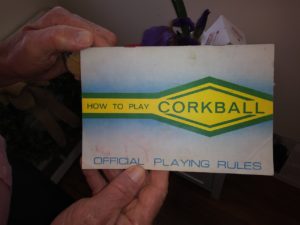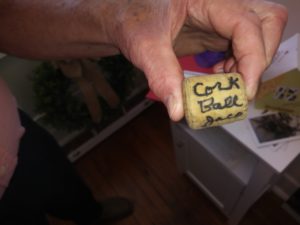“You take a regular size cork like you would have in a wine bottle and wrap it in masking tape. That is how you make a cork ball.” Jake Jaco pulls from his pocket one of the cork balls used in a tournament he put on in 1993 at his family’s bar, Jaco’s Corner. “It was a great game we played growing up because you didn’t need many people to play. You and a buddy could go play two friends in the backyard, or on the street or in an alleyway.”
Jaco smiled as he remembered his childhood growing up in the Olympia Mills village. Whatever the heart ache and struggles the adults had, you sure couldn’t tell it by his memories as a child.
“Then we would take a broomstick and use it for a bat. There were home runs and base hits. You didn’t need a lot of room or a big field”

Official Rules for Corkball originated in Olympia
Corkball came along at a time when games were invented for outdoors. Competition was always in the air. There were no formal leagues requiring proof of age or a medical waiver. This was a game where it could go as long or as short as you needed it to, depending on how much time mom let you play.
There are those who claim cork ball was invented in 1890 at the breweries in St. Louis, Missouri. Lunch breaks and shift work lent itself to an atmosphere that cork ball thrived in. With the advent of two world wars and a society connected by roadways and motorcars, it seemed to spread across the nation. The Sportsman’s Corkball club is still going strong in the pubs and sports bars there, and they even have a Facebook page: https://www.facebook.com/pg/sportsmanscorkball/about/?ref=page_internal.
Jaco is oblivious to all that history. In his mind, it is just a fun game from his youth growing up in the textile mill village outside of Columbia, SC. He was even surprised when T&T Sports in Columbia sent him a corkball game rule book created by some guy in West End, NC.
As he displayed the rule book from that small hamlet between Charlotte and Fayetteville, NC, he brushed it off by saying, “Those aren’t the rules we used.” He smiled and said, “We had a commissioner and everything!”
Doctoring a cork ball is more common than one would imagine and the commissioner had to step in 
Jaco produced his own set of rules that governed his local tournaments on the corner of Rosewood Dr. and Bluff Rd. There was a committee of three that oversaw the games and any issue not covered fell back the official baseball rules. Players had to bat “Opposite handed” and corks had to cross a certain line when hit or they were ruled out. It may never be a major draw in big league stadiums, but cork ball puts a twinkle in the eyes of every participant. Jake Jaco is proof of that. The rules may be a little different; depending on whether you are in St. Louis, Missouri, West End, NC or Columbia, SC, but a broomstick, a cork wrapped in tape and a few friends is all that is needed to play.
Eric Barnes is a retired member of law enforcement, a book author and writes for The Standard.
Please visit our sponsors and donate to support The Standard on this page.



 RSS - Posts
RSS - Posts